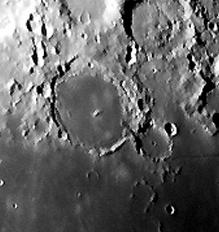Observing the Moon: Pitatus
Jack Kramer
Most features on the moon are of interest at certain times of the lunar month due to the ever-changing effects of light and shadow. The crater Pitatus is a prime example. It's an old, eroded crater with its floor and part of its wall inundated by lunar material that once flowed in a molten state during the formation of the adjacent Mare Nubium.
��
�Of particular interest here is a cleft in the west wall that allows a shaft of sunlight to spill onto the floor of the smaller adjacent crater Hesiodus. This phenomenon becomes visible for a couple of days just after first quarter phase when the craters are fully illuminated but near the terminator. The cleft is visible in the above image as a dark line through the wall separating Pitatus and Hesiodus. This image seems to have been taken about a day too late to show the effect -- the shadows aren't quite long enough. Typically, the west wall of Pitatus leaves the floor of Hesiodus partially in shadow, with the exception of a V-shaped patch of light beginning at the opening of the cleft. I have seen this easily in a 4-inch refractor at 150x.
Also note that adjacent to the east wall at the edge of the crater floor is a broken line of little mounds. This suggests that they might be the remnants of lower peaks of the wall that were partially flooded by the molten material that filled the crater floor. The mounds are visible when they are fully illuminated but the sun is still low enough for them to cast shadows.





